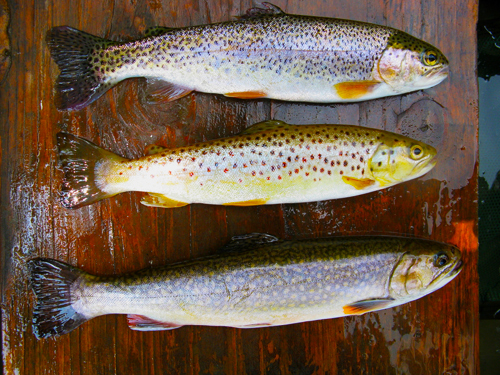BY Lee McClellan
This is the sixth of a series of articles detailing essential outdoor skills to learn before the warm winds of spring arrive in Kentucky.
FRANKFORT, Ky. – The deepest snow since Bill Clinton roamed the White House pounded Kentucky this week, leaving in its wake stranded cars, sore backs from shoveling snow and grumbling citizens.
It seems remote now, but in just a couple of weeks, we’ll be slipping on short sleeve fishing shirts and hitting the water. This bracing cold will soon pass.

Discovering emerging populations of sport fish in a lake or stream is a good skill to learn to increase your fishing success. It is also the easiest skill to learn concerning the outdoors.
Studying the 2015 Kentucky Fishing Forecast is all you need to do because fisheries biologists across the state recommend some improving fisheries to try each year. A printable version is available on the Kentucky Department of Fish and Wildlife Resources’ webpage at fw.ky.gov.
The rainbow and brown trout in the Cumberland River didn’t feel too good during the drawdown of Lake Cumberland to repair the ailing Wolf Creek Dam. The regular flushing of cold water into the Cumberland River slowed to a trickle in summer during the drawdown years and the once world class trout fishery in the river suffered. Things are really beginning to improve with the return of normal water levels in Lake Cumberland and the consequent higher flow into the river.
“We have more 12- to 15-inch rainbows in the Cumberland River than we have since 2007,” said Dave Dreves, fisheries research biologist for Kentucky Fish and Wildlife.
The brown trout in the Cumberland are also doing much better and this fishery should improve markedly in the future. “We have many 11- to 12-inch brown trout in the river right now and a good chunk of 13 to 15 inchers,” Dreves explained. “There will be some good fishing over the next few years for these species.”
The brook trout stockings in the Cumberland River that began in 2011 with 11,000 fish are an unqualified success with two new state record fish caught last year. As brook trout grow and prosper in the Cumberland River, this state record will likely fall again multiple times over the next several years.
The rock bass in the Elkhorn Creek system are a seriously underutilized fishery and the stream holds a fantastic population of these fish.
“We are seeing the highest numbers in 20 years of rock bass 8 inches and longer as well as 6- to 8-inch fish in the creek,” said Jeff Crosby, central fisheries district biologist for Kentucky Fish and Wildlife.
Rock bass make a great introductory fish for children or beginning anglers as they strike often and hard. Rock bass, also commonly called redeyes or goggle-eyes, bite willingly when other species refuse.
They make great sport on ultra-light spinning or spin-cast gear or on fly fishing equipment. Big rock bass often fool stream smallmouth bass anglers with a hard strike and determined fight, making the angler believe a nice smallmouth inhaled their offering, only to land an 8-inch rock bass.
Rock bass hang in eddies covered in foamy water, near undercut banks with exposed roots. They voraciously strike practically any in-line spinner cast near them, but also gobble 2-inch black curly-tailed grubs rigged on 1/16-ounce leadheads. Rock bass make excellent table fare with a firm, sweet flesh, comparable to bluegill in flavor.
The crappie fishing continues to improve in Lake Cumberland. Water now covers acres of young sycamore and other trees that sprouted on the exposed banks of the lake during the drawdown, making ideal crappie habitat. Population sampling conducted last year reveals a good population of 12- to 14-inch crappie in the lake.
“With the water levels back to normal, the fishing for practically all species in Lake Cumberland should improve with so much new habitat,” said Ron Brooks, director of fisheries for Kentucky Fish and Wildlife. “Crappie and other sunfish will especially benefit.”
John Williams, southeastern fisheries district biologist for the department, recommends trying the woody cover in the mouth of Laurel and Rockcastle rivers in the headwaters of the lake for productive early spring crappie fishing.
The shallow back ends of creek arms in Lake Cumberland all grew thick with brush and small trees during the drawdown. These areas also make excellent early spring crappie fishing spots on the lake.
Lake Cumberland crappie readily strike 2-inch red and chartreuse tubes fished on 1/32-ounce heads worked among the flooded trees along the edges of open water. They also strike minnows suspended under bobbers in the same areas. Crappie in Lake Cumberland tend to hold deeper than on other reservoirs.
Get out this spring and try some of these burgeoning fisheries. You may have a fish story for the ages to tell after a warm day spent fishing these waters.
Author Lee McClellan is a nationally award-winning associate editor for Kentucky Afield magazine, the official publication of the Kentucky Department of Fish and Wildlife Resources. He is a life-long hunter and angler, with a passion for smallmouth bass fishing.


Be the first to comment